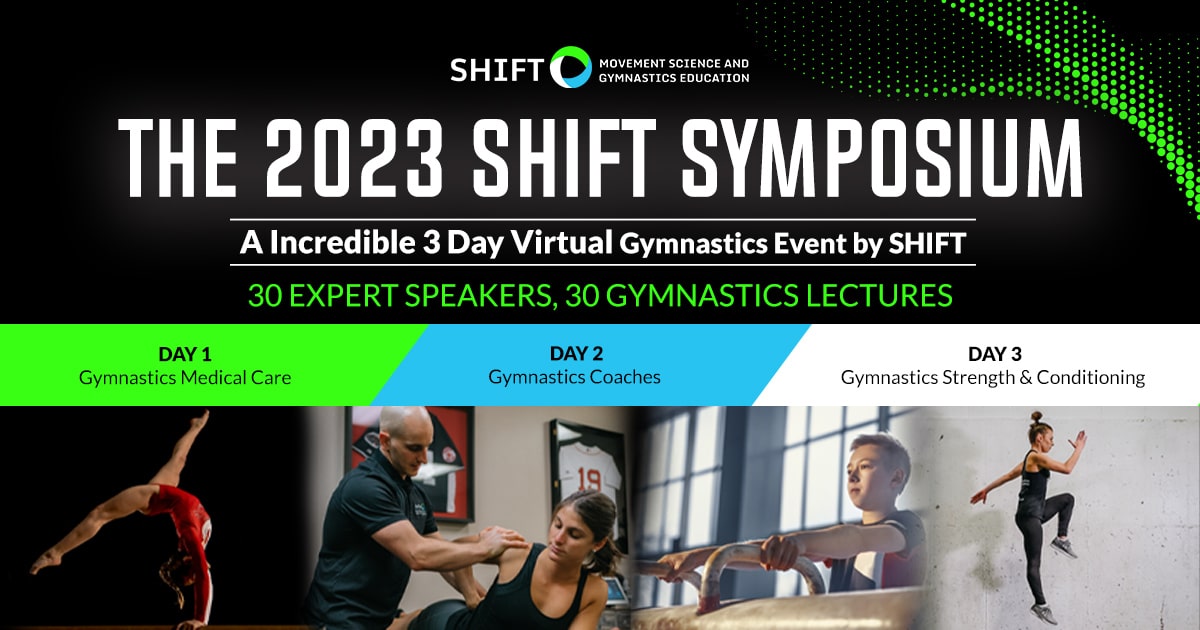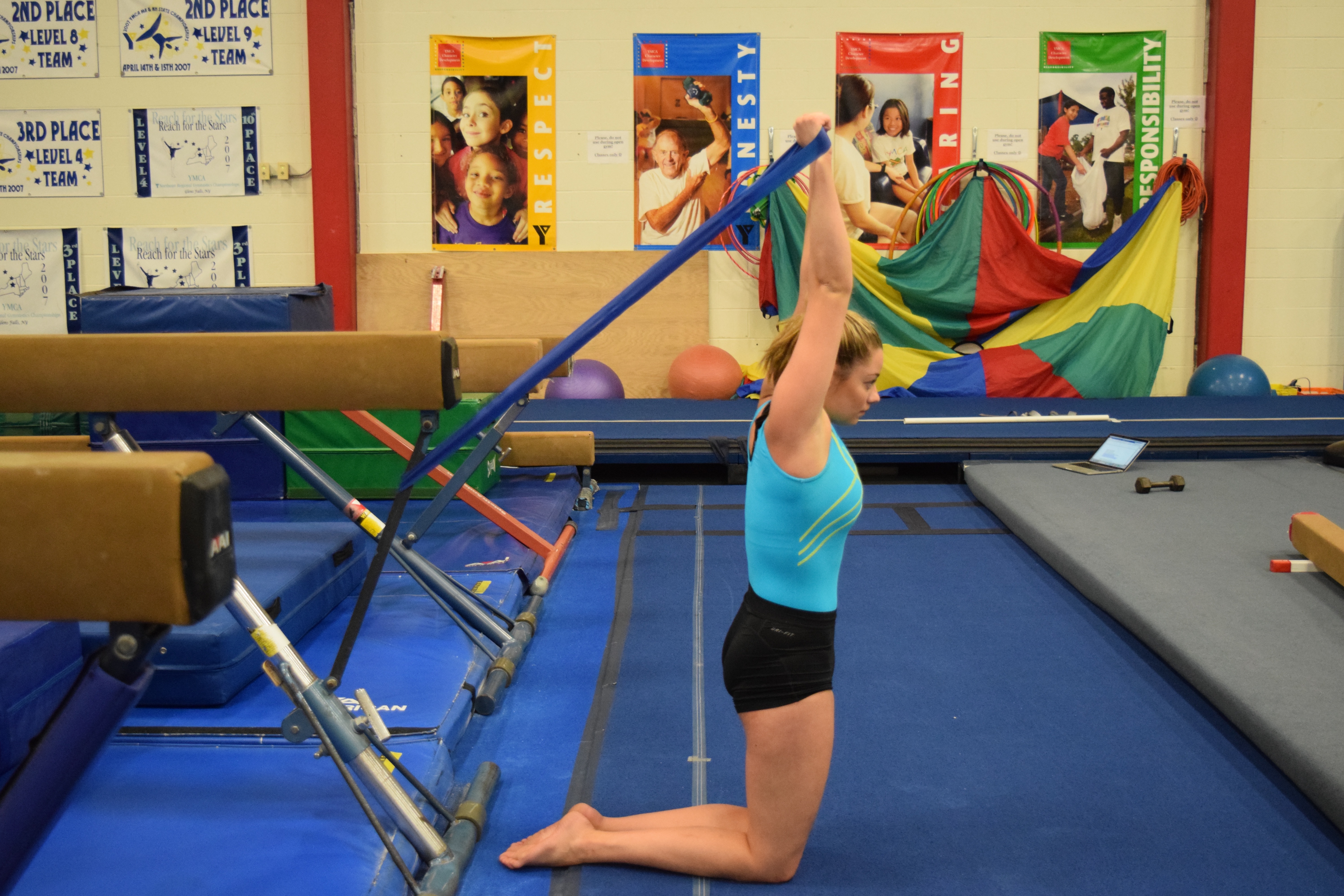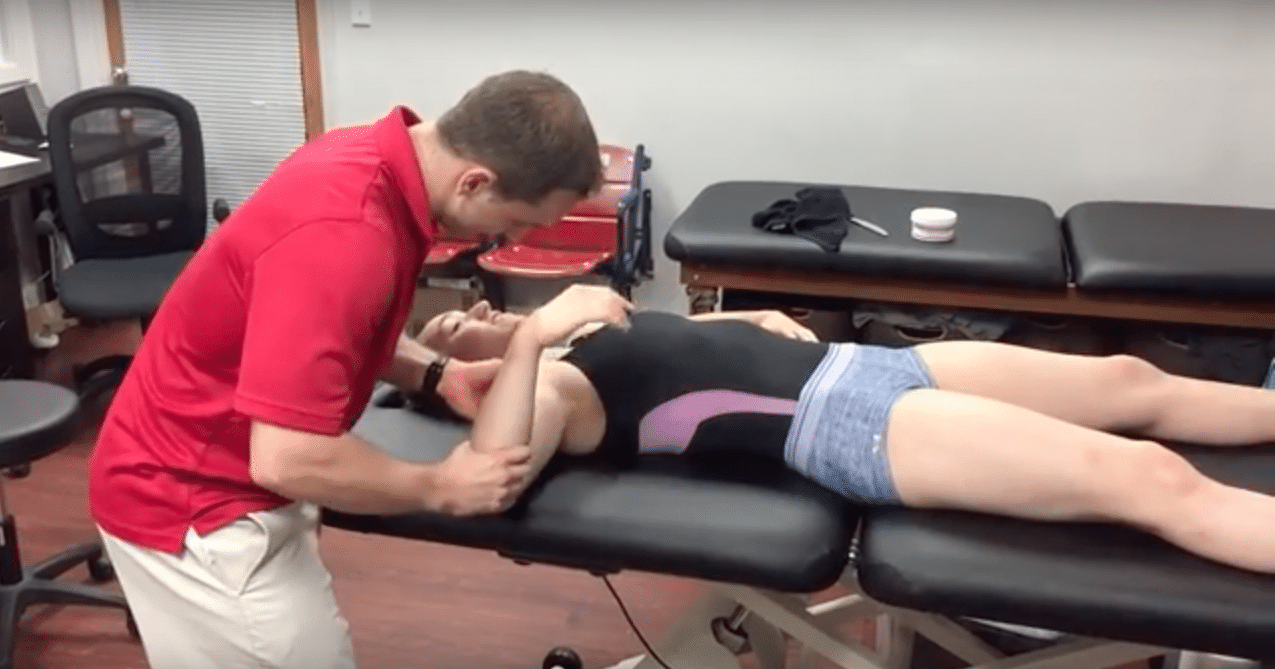Helping Gymnasts With Back Pain from Landing Forces
When people think of back pain in gymnastics, they typically think about the extreme back bending motions that cause stress fractures or “spondy” fractures. While this is for sure a big part of gymnasts having back pain, there are other factors that can cause it. One of them is landing and heavy impacts. In this quick blog update, I wanted to share a few thoughts as I have treated many gymnasts for this issue. I also think sometimes in the medical world, it might be overlooked if someone doesnt understand gymnastics super well.
Before I dig in though, if you are someone working in gymnastics who wants to learn about back pain, achilles issues, elbow OCD, and tons of non medical gymnastics drills, skills, and strength exercises, be sure to sign up for the 2023 virtual SHIFT Symposium we are hosting in June! This is going to be a monster 3 day event with 30 speakers and almsot 30 gymnastics lectures. I promise you will not want to miss out. Learn more here!
Table of Contents
Why Gymnasts Can Get Pain with Landing
High Impact Forces
As mentioned, alongside the repetitive back-bending motion, gymnastics also requires an enormous amount of impact (or compression) repetitions. Many different tumbling skills, vaulting skills, jumps/leaps, and dismounts put massive numbers of impacts on a gymnast’s spine. These impact forces are enormous, ranging from 15.9-18x bodyweight. If not properly trained for and approached slowly, it can create irritation of muscular tissues, the bones of the back, nerves around the spine, and something called the endplates.
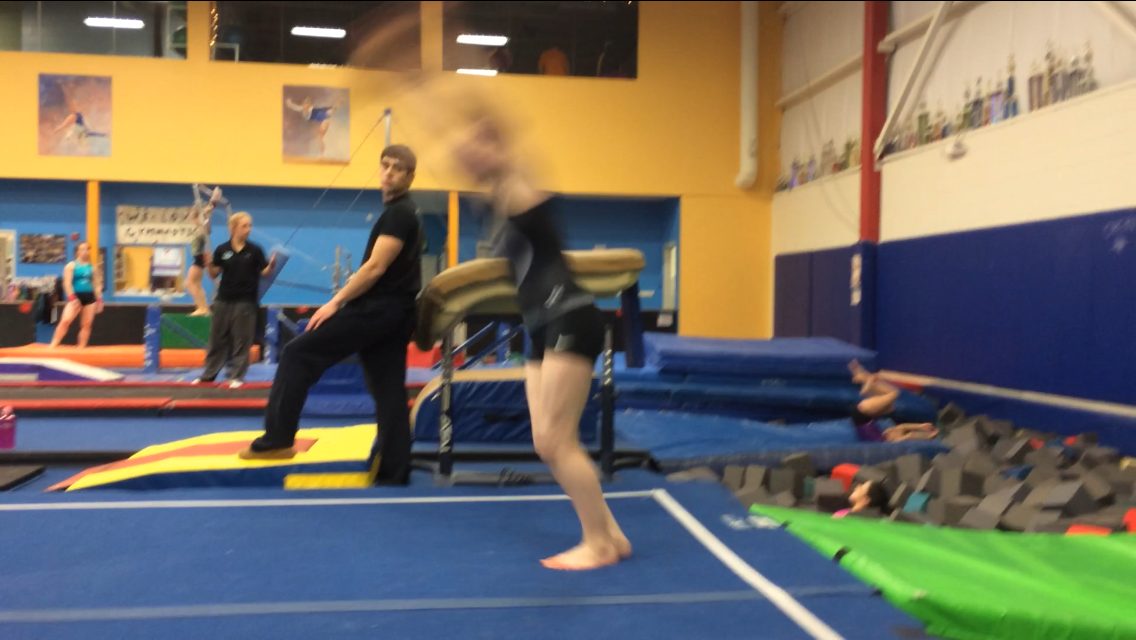
To be clear, these things are not inherently bad for gymnasts. I don’t want to scare people out of the sport. But due to how often these impacts occur, and how often gymnasts must do them to get skill progress, we have to be extremely calculated in how we approach our training with kids. If we don’t have a science-based, specific training program, these repetitions can add up fast and lead to possible back pain.
Lacking Science-Based Strength & Conditioning Methods
This is something that applies to all gymnastics injuries but in particular, impact-based low back pain. As mentioned, the forces on the lower back of gymnasts are massive. If you look at the sports medicine literature, it’s clear that other sports use science-based strength & conditioning to help reduce the risk of low back pain. This includes evidence-based, progressive weight training using dumbbells, kettlebells, medicine balls, and barbells.
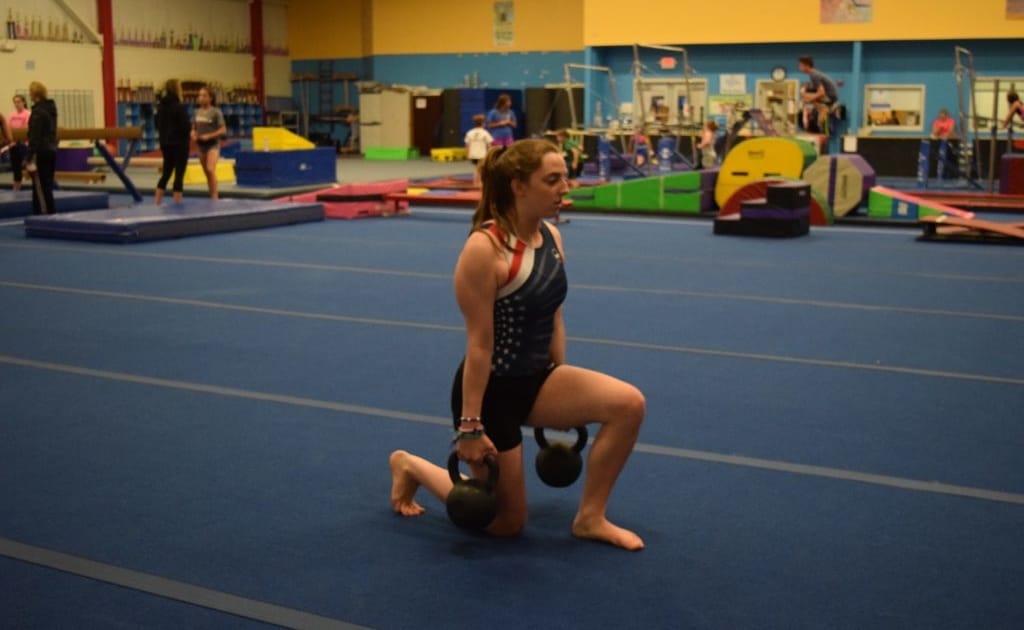
Based on great literature (more here, here, and here), it is clear that a properly done, properly coached, and properly progressed strength and conditioning program is beneficial for performance and reducing the risk of injuries. This includes a combination of both external weight lifting and bodyweight strength work. This type of training is huge to help build the core muscles, and the other dynamic stabilizers, to protect the ligaments, bones, and joint capsules in the lower back. Taking this one layer further, a lower body strength program can be insanely beneficial to help absorb the very high forces that gymnasts experience during their skills.
In every single program, I make for a gymnast recovering from back pain, there is external weight lifting for the legs and the core. It really is one of the best things that helps people get back. If we know that, I think we should apply those ideas to the preventative side of the fence.
Improper Landing Techniques Still Taught & Used
Another huge change that must be made in gymnastics to reduce the risk of lower back pain injuries is a sport-wide adoption of using science-based landing mechanics. It is unclear whether this comes from a lack of education, an ‘old school’ mindset, or a desire to mimic the esthetic type landing seen in ballet or dance.
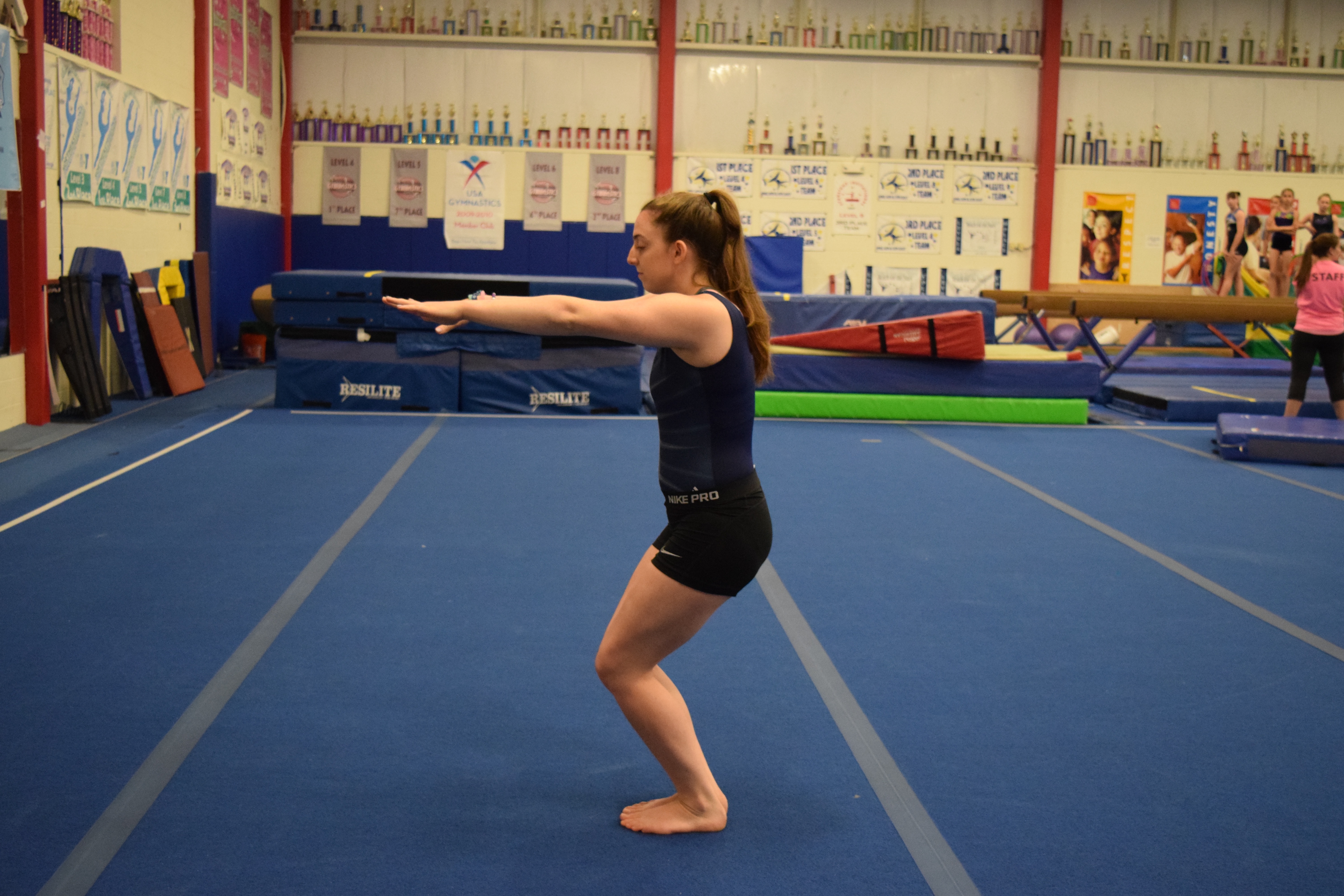
However due to this, many people in gymnastics still teach use, and judge, based on a landing position that is not supported by science to ideally help dissipate high forces. Many gymnasts still land with their feet together, torso upright, hips tucked under, and in a ‘knee’ dominant patterns that may shift more stress onto the back, knee, and ankle joints. In fact, it was recently shown in a study of elite gymnasts in the UK, that they tended to land with a ‘stiff’ landing pattern with an overextended lower back position.
This is in contrast to the suggested landing pattern, supported by enormous amounts of data, of a squat based landing that has the feet hip-width apart, knees tracking in line with the hip and feet, and the allowance of squatting to parallel depth so various musculature can be recruited to buffer forces.
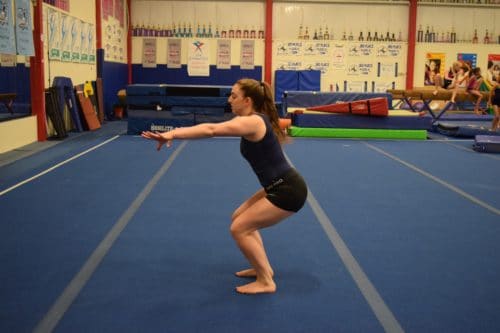
Until this becomes the gold standard for teaching gymnasts how to land in practice and competition, we may continue to see high back pain rates. I recently gave big presentations to the coaches and judges in the NCAA about this topic that you can check out here.
Are There Different Types of Impact-Based Back Pain in Gymnasts?
The interesting thing about this category of impact-based back pain is that it’s not a one size fits all. For some gymnasts, landing with their back in a rounded or flexed position is the biggest cause of their pain. This is because the heavy rounding of their spine under loading can irritate muscle structures, the discs within the back, and possibly the nerve endings. I see this most often with under-rotated vaults, tumbling passes, and dismounts.
For other gymnasts, they might actually have back pain triggered by impact from the complete opposite motion of overarching. In this instance, it’s not the discs and nerve ends that take pressure first, it’s usually the joints. In these situations, the joints bumping into each other under load is what triggers gymnasts’ pain. I see this most often with 1 1/2 punch skills on floor, or slightly rotated front tumbling skills.
How Do We Help Gymnasts Reduce Back Pain if Present?
The reality is that gymnastics is hard. No matter how much we try, we can’t reduce all the injury risks and things will happen. Heavy landings can easily cause lower back muscles, joints, or other structures to get cranky as outlined above. While I highly recommend people always work with and follow the guidance of medical professionals vs online advice, here are some things I regularly use.
1. Regular Light Motion
It’s important to remember that we want to keep gymnasts moving when they have pain. While we don’t want them to do the actual thing that caused their pain (i.e. jumping and landing or gymnastics skills) we do have to make sure its not complete bed rest. By doing small consistent motions, we can slowly keep the joints and muscles moving.
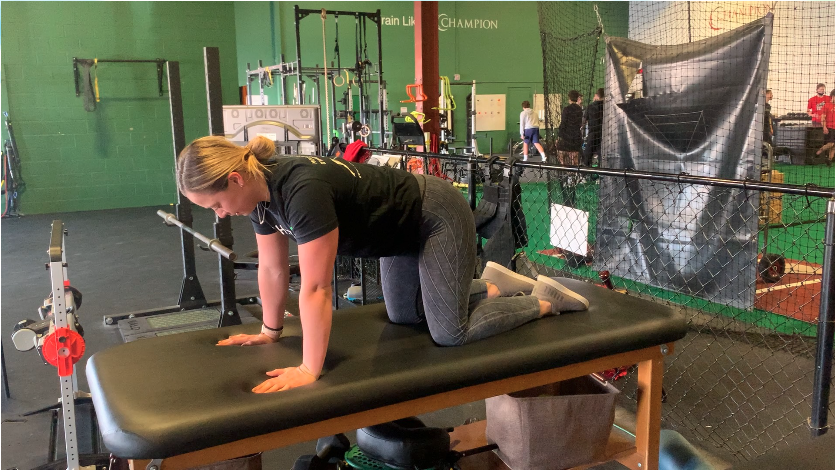
If someone has impact-based back pain when they round or flex their back and land, doing gentle cat camels as well as press-ups and mini backbends can help. In the opposite light, if someone has impact based back pain when they arch their back and land, doing gentle cat camels as well as rock back breathing can help.
I encourage gymnasts to do this 3-4x throughout the day to help reduce being in one spot for too long or getting stiff.
2. Mid Line Core Work
Similar to above, we want to keep the core working as much as we can in a nonprovocative way. We obviously don’t want someone doing core exercises that cause pain, as you might see in the gym with arch ups, leg lifts, or hollow rocks.
But, there are many other regressed midline core drills that are usually tolerated well. I personally like trying dead bugs, bird dogs, bent knee side planks, and plank drag-throughs.
Oftentimes if someone is lacking mobility in one area it might cause the lower back to overwork more during gymnastics skills. This is most commonly seen in the upper back, known as the thoracic spine, followed by the hips and shoulders. If a gymnast lacks mobility in the upper back to extend and rotate, they may start to overuse their lower back more. This could create a situation where the structures mentioned above become overworked, or possibly the joints/bones of the lower back also start to become irritated. For this reason, we must always screen thoracic mobility and correct it, or teach a gymnast how to use their upper back/shoulders to take pressure off their lower back.
Also, the hips need to be very strong to help absorb forces during landings. The glute muscles in particular, as well as the hamstrings and quads, need lots of attention. If a gymnast has struggled with hip nad leg strength, now is a great time to work it. I like single-leg hip lifts, step-ups, split squats, and sled pushes as well as sid band.
4. Modalities Like Heat and Soft Tissue
There is a huge debate out there on if manual therapy and things like heat are useful or a complete waste of time. This blog is not the time to debate this, but I will say that while not the main focus of my treatment compared to education and exercise, I do use both. In the very acute phase, we are looking for any way to reduce sensitivity levels and calm down someone’s back. If 5-10 minutes of heat and manual therapy make a patient feel and move better, and it allows them to tolerate exercise better, I’m all for it. That said, I try to move to exercise work as fast as possible.
5. Education About Daily Life Activities
One of the biggest reasons we need to know what is movement category is causing pain, is so that we can help use the opposite motions to make someone feel better. If a gymnast has a lot of pain triggered by back bending or extension with impact, we are going to want to educate them on how to do the opposite. I tell gymnasts who have pain with arching that they can do some hands and knees cat camels that only move from neutral to hollow, and rock back deep breathing drills, throughout the day to help reduce acute pain levels. I also tell them how very long periods of standing or walking might be problematic in the first few weeks, so building in times to sit can help.
In the opposite light, I tell gymnasts who have pain with rounding or hollowing with impact to use cat camels moving from neutral to arching, and time laying on their stomachs, to help. Doing small press up exercises, or mini backbends throughout the day, can be very helpful. I also tell them to not sit in low couches, and if they do sit try to put a rolled-up sweater in the arch of their lower back ot prevent excessive rounding. I also tell them to set a timer and try to not sit for more than 20 minutes in the first few days.
As you can see here, it’s crucial that we know why someone has pain so that we can help them do the opposite. It may not be an instant fix, as sometimes the first 7-14 days can acute pain that is more chemical inflammation in nature, or acute guarding, that doesn’t respond super well to any motion. In this case, I tell gymnasts to do whatever they can to be comfortable, maintain a regular routine of switching positions, and start PT ASAP for pain relief strategies.
How Do We Safely Get Gymnasts Back to Gymnastics?
Generally the 4-6 to 10-12 week mark, is about progressing exercise programs to build local lower back and global capacity. We want to use exercise and ongoing education as our main tools to help rebuild their capacity. At this point, if workloads have been reduced and the time has been put in place, gymnasts are starting to feel a bit better. In some more significant situations, like full spondy fractures or more intense disc herniations, it might still take a bit to feel great.
Progress Core and Global Exercise
The first, and most important, task is to make the exercise program harder. This not only allows us to physically load the core and lower back structures more but also help rebuild mental confidence. A gymnast wants to know that their back can handle harder exercises, and higher forces, without increasing symptoms. Also, sometimes loading of the lower back and core over time helps to continue to reduce sensitivity levels and fear about movements.
For this, I try to build a basic and well-balanced strength program. For the lower body patterns, I build in split squats, step-ups, single-leg hip lifts, box goblet squats, physioball curl-ins, and outer hip work like sideband walks. For the core, I try to get every main core area. I like to progress the basic core work to bear crawls, wall press dead bugs, full side planks, front plank drag throughs, suitcase carries, farmer carries, and sled pushes.
Restore Unloaded Spine Mobility
We want to make sure that we restore full lower back spine motion. For one, we want a gymnast to feel safe and comfortable knowing that they can move their spine. Along with this, gymnast requires a notable amount of lower back motion during skills. This is the first step in making sure we have this motion available so that in the next phase we can progress back to more explosive power work and basic gymnastics skills.
I use the cat camel motions in full range, press-ups, quadruped rock backs, and dynamic warm-up stretches as the main way to do this. It’s normal for small amounts of discomfort, and I approach. this with a ‘consistency over intensity” mindset.
Resorting Core Power
This is where things start to pick back up and get more exciting. This is during the 12-20 week phase usually and involves much more power, speed, and gymnastics-specific work. It is crucial to note that while most gymnasts will not be in pain, or feel limited, they can not rush here. I have seen so many gymnasts try to ‘test the waters with skills or competing during this phase, only to flare their back up again and be really frustrated with the setback. Take it from me, go slow, and go through the proper steps. The forces of even basic gymnastics skills are massive compared to daily life. Not to mention, gymnasts have likely only had a few weeks of real strength work under their belt and may not be in peak condition for full practices/meets.
The first thing I spend a ton of time working on is getting back advanced power and core work. Gymnastics demands a massive amount of fast twitch power output. If we never expose the lower back and core to this type of force before we reintroduce gymnastics skills, it might spike the amount of workload and bring about symptoms.
My personal favorite way of going about this is using medballs. I find that many of the movements seen in gymnastics can be trained with medicine ball throws and slams. It helps gymnasts rebuild their tolerance and comfort with fast ballistic motions, but not in gymnastics-specific settings. I use medicine ball slams, seated overhead medball throws that progress to standing overhead throws, side-to-side medball slams, and tall kneeling chest passes as my favorites.
Return to Jumping & Running
We also need to make sure that we return to jumping, landing, and running. This is often an intimidating area for gymnasts and medical providers, but if the first few phases are done well, there is typically no issue with starting to do impact work. Keep in mind for some injuries like cartilage damage or fractures, will take a while and will require clearance from a doctor/surgeon. These are the exercises I use to start this
- 20 Pogo hops
- 20 In and out hops
- 20 Scissor hops
- 2 laps Jogging laps forwards and backwards
- 2 laps Skipping laps forward and sideways
- 2 laps Carioca and side shufle laps
Return to Impact Gymnastics Skills
This is another very important, yet sometimes murky, area of gymnastics rehabilitation. While there has been great work by some researchers suggesting sports progressions, and other work to look at in baseball/tennis/golf, the reality is that gymnastics still largely has a lack of objective science-based return to sport protocols. Based on these tools and others, there are 3 main variables that I use to make a return to gymnastics programs for those trying to get back to heavy impacts.
- Surface – soft surfaces like pit/trampoline, to medium surfaces like rod strips and using 8″ mats, to hard surfaces like spring floors or beams
- Force per skill – low impact force basics and drills, to moderate impact force skill or skill combination work, to high force power tumbling or vaulting or dismounts
- Repetitions – low repetitions per week, to moderate repetitions per week, to high repetitions per week
When I make these programs, I take the skills that a gymnast is currently performing and map them across the week. I have gymnasts do skill work 3 days per week, with 24 hours in between, while maintaining their strength program. I typically progress them every 2 weeks, making sure not to increase the surface demand, force per skill, and repetitions all at once. This typically looks like
- Weeks ½ – Soft Surface, Drills/Basics, Low Repetition volume
- Weeks ¾ – Soft/Medium Surface, Skills, Moderate Repetition volume
- Weeks ⅚ – Medium/hard, Harder skills, Moderate Skill Volume
- Week ⅞ – Hard Surfaces, Hard Skills, no > 7 reps per skill per day
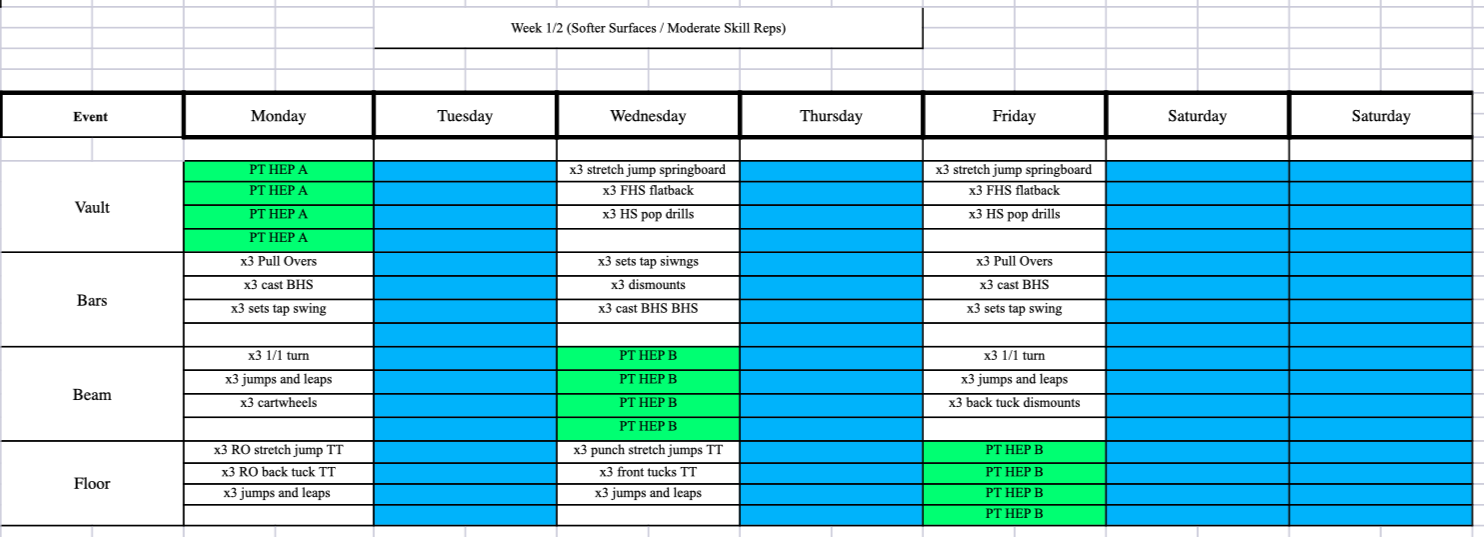
How Long Will It Take for A Gymnasts Back Pain to Go Away?
We must keep in mind that while there is great science on the healing timelines for many common back injuries, there is still a huge variability that can occur. In the big picture, factors like age, genetics, skill level, genetics, past injury history, and more all play a role. Also, the severity and reoccurrence of the injury will make a huge difference in the overall healing timeline. Also, as you can see above, there is a huge spread in the different types of movements that cause pain, the skills that re involved, and what structures might be irritated.
Oftentimes I will hear people compare one gymnast’s injury to another. Saying that “X” back injury took 4 weeks in one person, so a sort of similar “Y” injury in another person will be the same. I strongly recommend people do not do this. Even with what seems like the exact same injury, say stress reaction or muscle spasm, due to many factors mentioned above and more the full return to gymnastics this could be wildly different.
A useful rule of thumb to use with people is that for however long a gymnast is out of practice with their injury, it will take 2-3 times as long to return. So say someone has a mild muscle strain that keeps them out for 2 weeks, it will likely take them 4-6 weeks more to fully return. If someone has a stress fracture that keeps them out for 3 months, it will likely take an additional 3-4 months to get back fully.
This being said, in my experience and based on the scientific literature, with less severe injuries like muscular strains and low-level joint irritation, it could be very benign and only take 2-4 weeks to recover.
As the severity of the injury progresses, the timelines extend. For higher degree, muscular strains, disc or nerve issues, or stress reactions, the timeline may extend into the 4-8 week range.
Lastly, the most severe injuries occur like full spondy fractures, sciatica or significant nerve pain, end plate fractures, and decompression surgeries may easily take 4-6+ months to recover from.
Conclusion
In an effort to not make this blog super long or boring, I’m going to leave it there so people feel like they get a good dose of information.
Keep in mind, if you are someone wanting to learn all about gymnastics back pain, as well as tons of other topics like drills, skills, strength and conditioning, injuries, culture, and more, be sure to sign up for the 2023 virtual SHIFT Symposium!
It will be 3 jampacked 3 days with 30 lectures on the most commonly requested topics people had. You won’t want to miss it I promise!


